The Wikipedia article on Rubus occidentalis, the wild black raspberry that is native to much of the Midwest, is refreshingly brief. Its relative failure to attract the idle wisdom of the crowds in the cloud suggests that this bashful berry has yet to become widely celebrated in the popular consciousness — except regionally, and then mostly amongst foragers in the know.
One of its alternative scientific names, Melanobatus michiganus, is suggestive of this possibility, resonating with its particular abundance in this state and also with my personal experience. For it was upon moving to another state as a child, where I would no longer find it in the wild, that the memory of their glossy black cap and their now-exotic flavor became recurring characters in my recollection of the mild Michigan summers I had left behind.
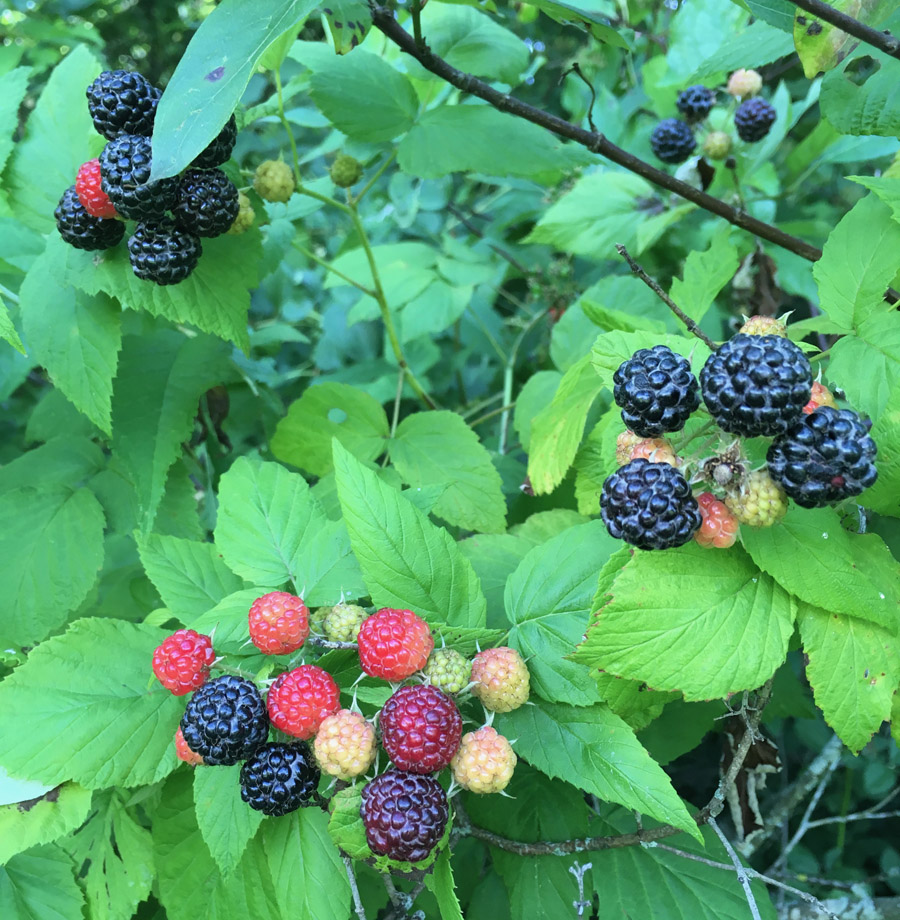
Two-track treasures
During those summers, a few black raspberry bushes could be found on the margins of our ten acres, but they produced barely enough to whet an appetite. It was only when I or my brothers indulged our freedom to roam that we could possibly be left with enough for jams or pies after sating ourselves. The best berrying ground was about a mile away, on a vast tract of fallow land grown up in brush and small woods, spanning both sides of a rural dirt road. Networked with informal bridle trails, this unfarmed land of unclear ownership had long been used by locals for horseback riding. In recognition of this practice, the township had been moved to erect signage that warned of “Horses Crossing,” at the point where the riders tended to cross the road. These two unusual signs, one much older than the other and which consisted merely of the two words in block lettering, led us and possibly a few other locals to refer to this otherwise unnamed place by the words on the sign.
Many of the trails had gradually widened into two-track lanes by the passage of the occasional car, driven either by teenagers furtively parking with their dates, or as often, by adults furtively dumping unwanted items. On the rare occasions I was able to visit, these mysterious meandering paths and their random turnouts presented to me as a sort of wonderland — a maze of roads-less-traveled, all bending into the undergrowth; where around any bend one might meet with intrigue or treasure — if not a box turtle or a bullfrog, or a clump of wild asparagus or a laden berry bush, then a discarded item with significant scrap metal value — often a critical supplement to our highly unreliable allowances.
This was also the perfect habitat for black raspberries, which had formed vast brambles that taunted prospective pickers with an expanse of ripened fruit stretching far into the thorny brush, flirtatiously beckoning from where they must have known that only a bird could possibly reach.
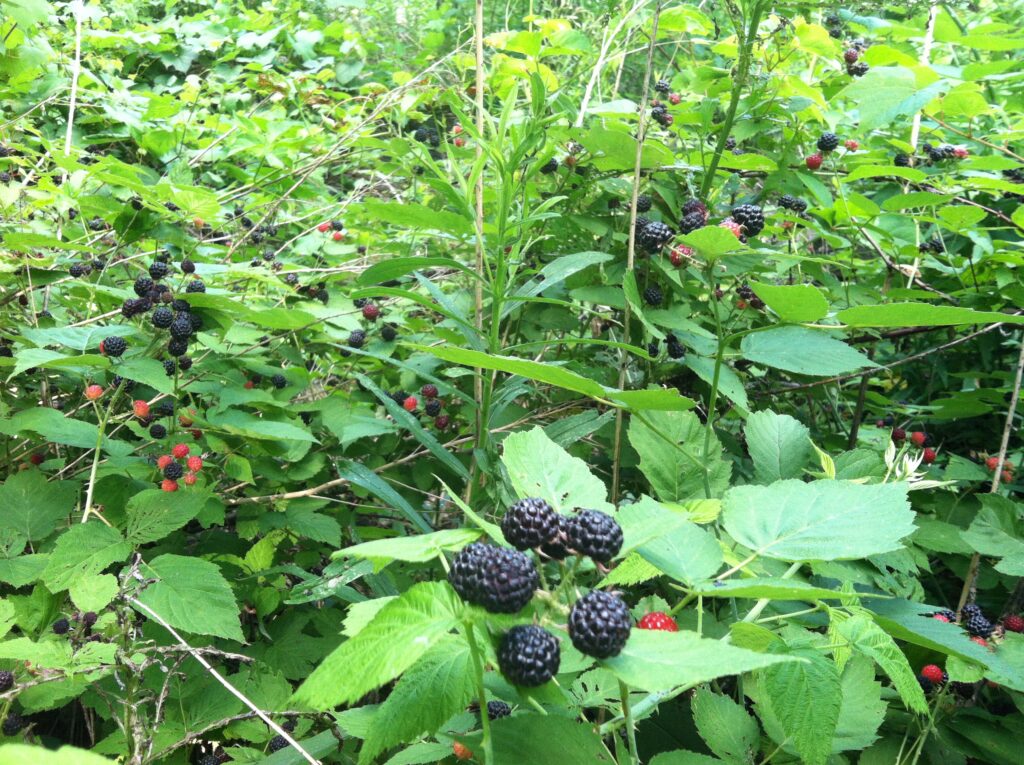
That place is long gone, no longer a gathering place for horseback riders and random discoveries, but for hundreds upon hundreds of manufactured homes, whose indifferent residents exhibit no outward signs of sentiment for bridle trails, berry patches or two-track lanes.
Splat
Now it is always with the appearance of purple blotches on the walks and steps of my own backyard that I become aware that July is suddenly upon us again. The birds are always first to discover this fugacious seasonal treat, the only purple foodstuff to be found at this time of year, or else the only one whose purpleness survives their gut so well. Yet as much as I may intrude on their party, the greedy maw of my berry-basket always leaves plenty for all. The birds’ interest seems to wane after a week or two, and copious amounts always end up languishing on the canes by mid-month, gradually drying out or falling back to the earth below, their opportunity spent.
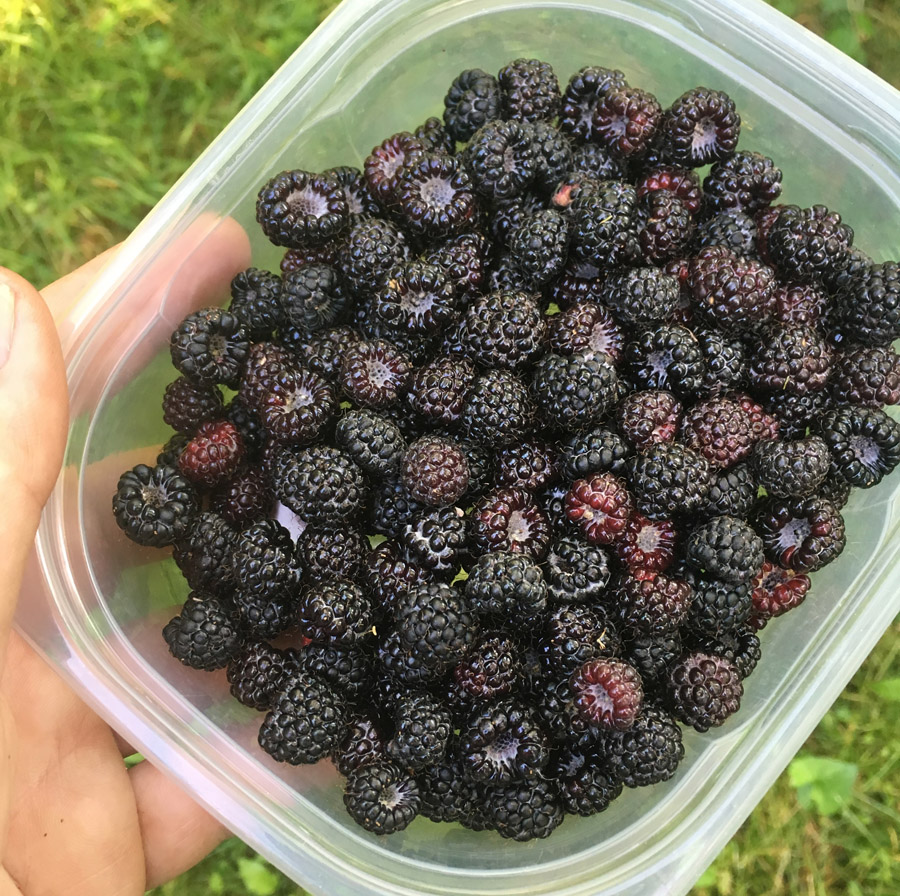
Well traveled
The black raspberry embodies something of a traveling nature. Its mobility on the wings of a bird is explained by the heavy coat on its seeds, which cleverly require the action of a bird’s gizzard in order to germinate. While plants are not likely conscious of the benefits of spreading out, this feature tends to prevent the sprouts of fallen berries from competing with their parents, and of course promotes expansion of the species’ range. It also means that the human, for whom their abundant seeds only get stuck in the teeth, must nonetheless respect this plan. If we want the bounty of the berry, we must agree to be saddled with the seeds — a natural contract by which many children find an early lesson in taking the bad with the good.
This seed-dispersal plan doesn’t mean that their tendency to form large brambles isn’t assisted to some degree by birds returning for supper, after lunch at the same venue. But brambles primarily form by underground shoots that surface a few feet away from the main plant — and sometimes re-entering the earth, wherever a cane grows long enough to arc back down to the ground. Once rooted at both ends, it might forget which way is up, but no matter; a fruiting cane is already in the second of its two years, and the newly rooted end will carry its business forward by someday sprouting another cane.
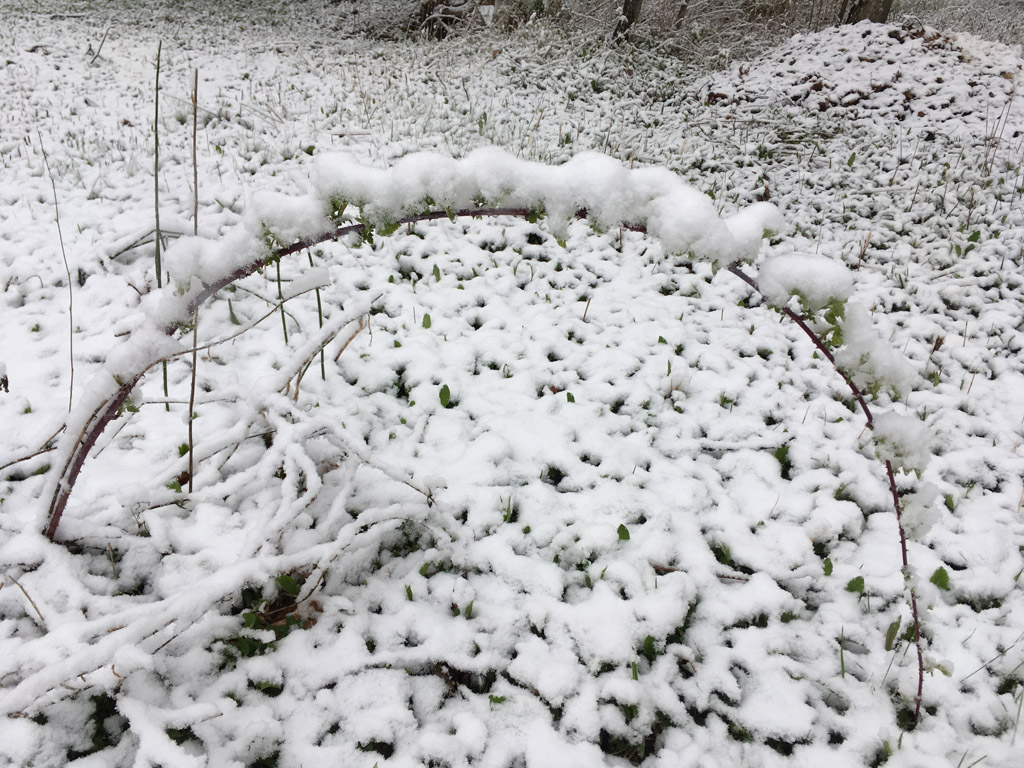
Rubus occidentalis also carries a geographic reference in the second part of its name. It is formed from the word ‘occidental,’ which is the lesser-known opposite of ‘oriental,’ a term that once was popular as a label for things of the Eastern world. Thus Rubus occidentalis quite literally means the raspberry of the West.
This implies the existence of native raspberries in the East, as is testified to by at least the Korean blackberry, Rubus coreanus, another black raspberry that forms the basis of a traditional wine called bokbunja-ju, which I have tried and enjoyed. But as sure as East meets West, today most Korean bokbunja-ju is made from our Rubus occidentalis, which has proven an apt adaptee to the Asian berry farm.
When encountered organically in a roadside bramble, the black raspberry exhibits a distinctly obliging nature — clearly signaling its ripeness by its blackness, and only then becoming easily detachable from the bush. But the fruit-to-thorn ratio is low, making the canes quite tedious to pick. Once picked, they are more fragile than most berries; even a shallow flat can barely bear its own weight without crushing a few at the bottom, staining anything underneath with a lingering purple stain. In fact, the concentrated juice of the black raspberry is said to have been used for decades as the ink with which the USDA stamped its inspection marks on cuts of meat — and its effectiveness for this purpose is demonstrated every time we stain our fingers and lips.
According to Wikipedia, the largest commercial representation of R. occidentalis in the U.S. is a cultivar called Munger, consisting of a total of about 1,500 acres in the Willamette Valley of Oregon. If we can believe the same source, these are mechanically harvested and are primarily used in frozen fruit and juice products. Elsewhere, black raspberries are only commercially grown on a very small scale, appearing mostly at farmer’s markets in July.
An Elysian veil
When encountered in its natural habitat, the re-rooting behavior of the black raspberry means that, with a little imagination, a large bramble can resemble a sort of wiry sea serpent, with canes looping in and out of the ground to feed an unseen body below. The frosted purple stems, arcing from one point to another, are easy to spot in the winter by the unique burgundy color they lend to the lifeless terrain, and by their delicate lavender blush. Wandering a winter landscape, the keen observer thereby knows where to return to, when the weather finally warms.
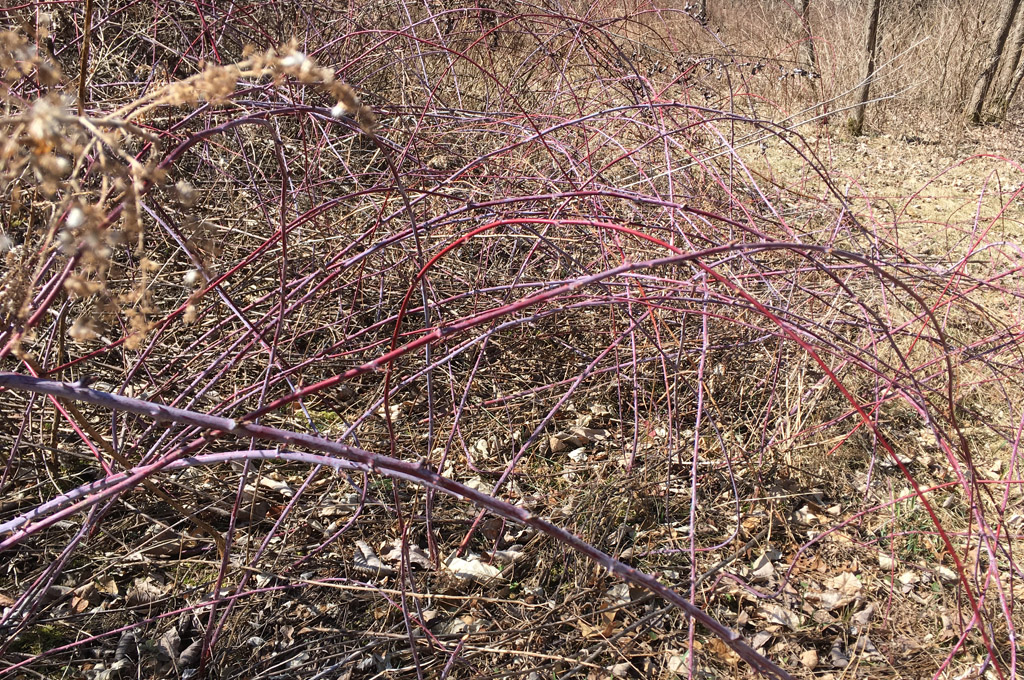
The frosty blush only appears on second-year canes that are ready to bear fruit. Its hazy, purplish cast intrigued Henry David Thoreau, who seems to have known the black raspberry as the ‘thimble-berry’:
I see in the path some rank thimble-berry shoots covered with that peculiar hoary bloom very thickly. It is only rubbed off in a few places down to the purple skin, by some passing hunter perchance. It is a very singular and delicate outer coat, surely, for a plant to wear. […] It is the coup de grace, the last touch and perfection of any work, a thin elysian veil cast over it, through which it may be viewed.
– Journal, November 3, 1857.
Today, ‘thimbleberry’ most often refers to Rubus parviflorus, whose native range is primarily west of the Rockies and does not appear to overlap with Thoreau’s Massachusetts. Together with his description of a frosty bloom on purple canes, and a mention that the berry is black (parviflorus is red), we can fairly assume that his ‘thimble-berry’ is our black raspberry.
Thoreau also speaks in more than one place of a rather odd practice, apparently personal, of stringing the berries on the stems of something he calls ‘herd’s-grass’:
The black thimble-berry is an honest, homely berry, now drying up as usual. I used to have a pleasant time stringing them on herd’s-grass stems, tracing the wall-sides for them.
– Journal, July 16, 1851
In trying to make sense of this passage, it helps to understand that stone walls and fences (‘wall-sides’) were much more common in stony Concord than here. I similarly find that tracing the partially shaded fencerows of the nearby fields can deliver a good yield of berries.
But I had never heard of stringing the berries together. What is this, I thought?
A quick web search shows that today, herd’s-grass is better known as Timothy-grass (Phleum pratense). Indeed, this common variety of hayfield grass becomes prominent in many open pastures at the same time as the black raspberry, and has a stiff and straight cylindrical stem, suited to support its large, cattail-like flower head.
Directly behind the field of Timothy-grass below is a patch of black raspberries, ripe for the picking. Let’s give it a try!

I plucked a couple of Timothy stems by grasping them with a fist on the smooth part of the stem and briskly pulling up — something I did often as a child while walking along unmown paths. They separated cleanly, each leaving about twelve inches of perfectly uniform stem. Holding a free end, I slowly poked it through a berry, from the inside of the cap. By going slowly, I could usually avoid breaking the berry by allowing the stem to find its way through the flesh between the seeds. It was quite effortless to collect a few dozen in this way, and they weren’t the least bit damaged — lasting an additional day in the fridge before I succumbed.
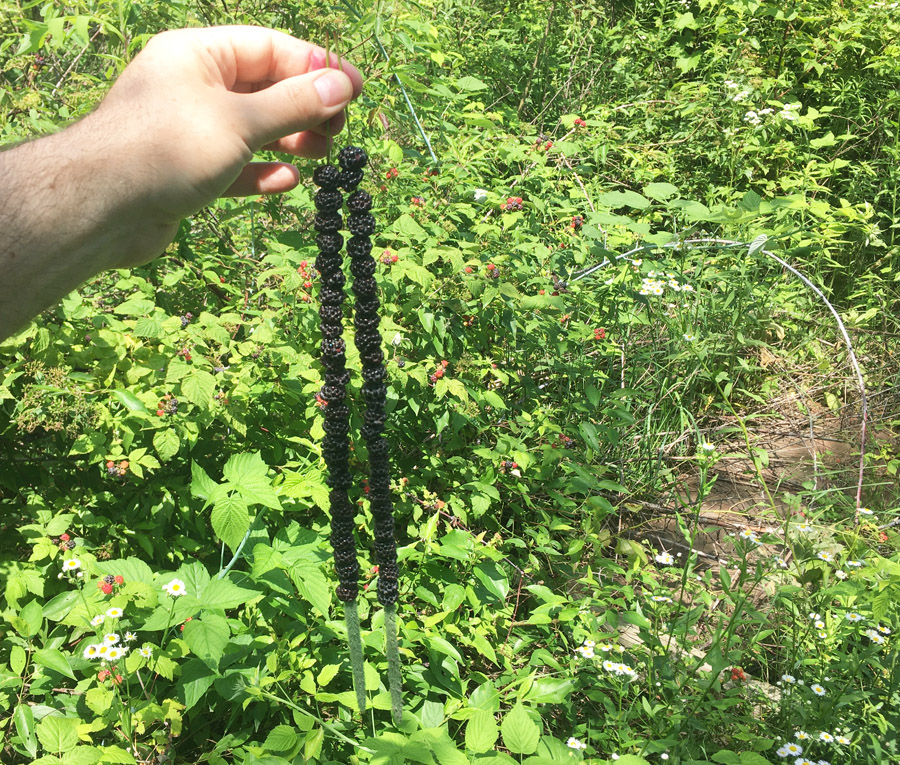
It is fair to wonder if anyone has strung black raspberries on stems of Timothy-grass since the time of Thoreau. I wouldn’t presume to be the first. But I can report that it works quite well as a way to gather a good number of berries, when caught in the field without a basket.
Resisting the pressure of commercial exploitation, the black raspberry is still true to its form — a treat that stubbornly remains both seasonal and regional. It may be the “raspberry of the West,” but the patience it demands for the yield it provides poses a bit of a challenge to Western sensibilities.
In its resistance to commerce, it seems to share some of the same elusive quality that Thoreau attributed to the berry he most preferred, the huckleberry:
The fruits do not yield their true flavor to the purchaser of them, nor to him who raises them for the market. There is but one way to obtain it, yet few take that way. If you would know the flavor of huckleberries, ask the cow-boy or the partridge. It is a vulgar error to suppose that you have tasted huckleberries who never plucked them.
– Walden, Chapter IX
Unavailable for all but two weeks of the year, the wild black raspberry thus remains closely identified with the locale and seasonality of its natural range — returning annually as a brief but faithful fixture of a forager’s Midwest summer.
Article and photos Copyright 2023.
To be notified of new articles, visit https://whatshallweweird.com/subscribe/


